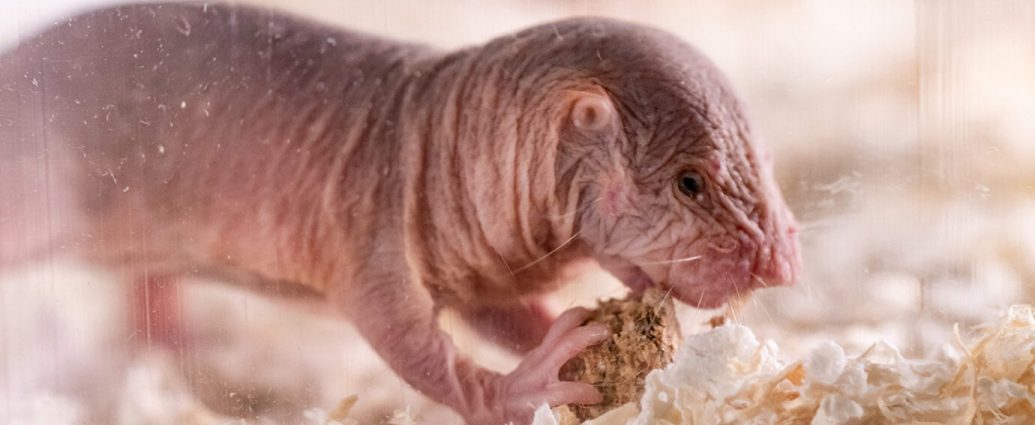The different vocalizations may help colony members tell friend from foe

When one naked mole-rat encounters another, the accent of their chirps might reveal whether they’re friends or foes.
These social rodents are famous for their wrinkly, hairless appearance. But hang around one of their colonies for a while, and you’ll notice something else — they’re a chatty bunch. Their underground burrows resound with near-constant chirps, grunts, squeaks and squeals.
Now, computer algorithms have uncovered a hidden order within this cacophony, researchers report in the Jan. 29 Science. These distinctive chirps, which pups learn when they’re young, help the mostly blind, xenophobic rodents discern who belongs, strengthening the bonds that maintain cohesion in these highly cooperative groups.
“Language is really important for extreme social behavior, in humans, dolphins, elephants or birds,” says Thomas Park, a biologist at the University of Illinois Chicago who wasn’t involved in the study. This work shows naked mole-rats (Heterocephalus glaber) belong in those ranks as well, Park says.
Naked mole-rat groups seem more like ant or termite colonies than mammalian societies. Every colony has a single breeding queen who suppresses the reproduction of tens to hundreds of nonbreeding worker rats that dig elaborate subterranean tunnels in search of tubers in eastern Africa (SN: 10/18/04). Food is scarce, and the rodents vigorously attack intruders from other colonies. While researchers have long noted the rat’s raucous chatter, few actually studied it.
“Naked mole-rats are incredibly cooperative and incredibly vocal, and no one has really looked into how these two features influence one another,” says Alison Barker, a neuroscientist at the Max Delbrück Center for Molecular Medicine in Berlin.
To start, she and her colleagues leveraged the computing power of machine learning to analyze over 30,000 “soft chirps” — a common vocalization — from seven laboratory colonies over two years. The analysis revealed that each colony had a unique sound, varying primarily in frequency and how much that frequency changes within a single chirp.
Naked mole-rats pick up on these differences too, replying to the sounds of their own colony with frequent chirping, but largely ignoring foreign dialects, the researchers found. “That surprised us, and suggests soft chirps might signal that a naked mole-rat belongs to the colony,” Barker says. The naked mole-rats aren’t just responding to voices they’ve heard before either, as artificially concocted calls matched to a specific dialect also elicited a response.
A bit of luck allowed Barker and her colleagues to test whether these dialects are learned or genetically encoded. Most colonies reject outsiders, but sometimes pups from other groups can get adopted by a colony (SN: 10/20/20). Multiple laboratory populations produced new litters around the same time, allowing the researchers to switch three youngsters to new colonies. If dialect stems from genetics, these outsiders should still sound like outsiders. But if dialects are learned, transplanted pups should sound like their new brethren.
The latter was true. And the closer to birth a pup was moved, the more closely it matched the dialect of its new home.
“A sample size of three is small, but these are really difficult experiments to do,” says Chris Faulkes, an evolutionary biologist at Queen Mary University of London who wasn’t involved in the study. Still, he says the results strongly suggest that dialects of naked mole-rats are learned, similar to those of humans, cetaceans and some birds (SN: 7/2/20).
While a colony’s sound is distinctive, it’s not fixed. In periods of anarchy — when a queen dies and is not yet replaced — dialects started to dissolve, becoming much more variable, the researchers found. Once a new queen emerged, the colony cohered again, suggesting that in addition to suppressing reproduction, queens also somehow control a colony’s voice.
Dialects probably play a role in maintaining the “exquisite cooperation” of naked mole-rat societies, Barker says. But they also reflect how vocal communication is another means by which queens suppress the individual interests of colony members for the good of the group.
“We tend to think of this communication and cooperation as positive aspects of naked mole-rat culture, but individuals are rigidly controlled in their behavior by the queen,” Barker says. “It gives them a huge survival advantage, but it’s a bit like living in an oppressive regime.”





















